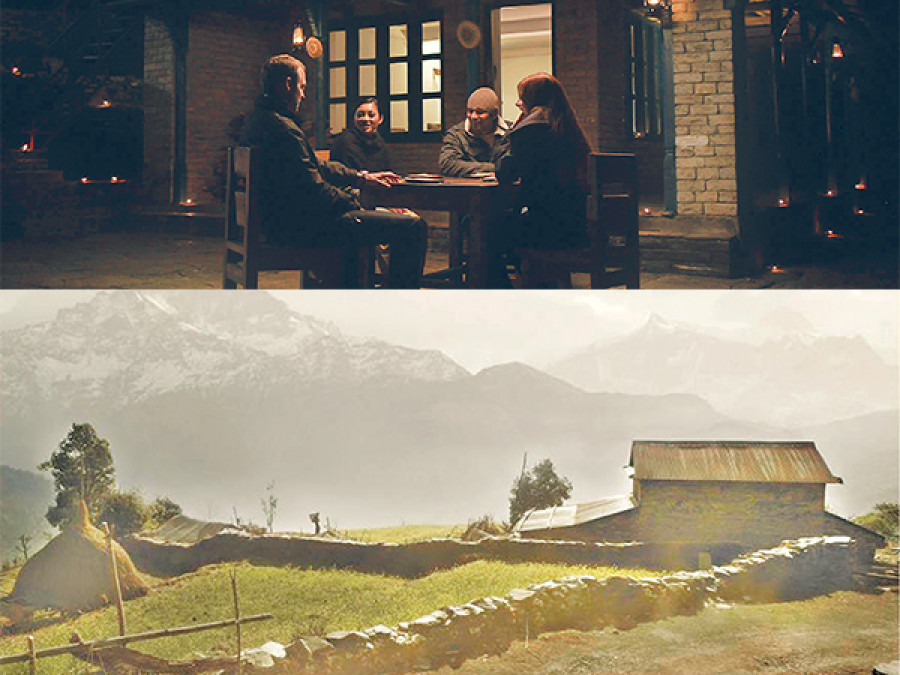Miscellaneous
Clash of the worlds
There are attempts at something resembling self-reflexivity in the newly released Highway to Dhampus. In what can be read as almost a personal disclaimer on the part of director Rick McFarland...
Preena Shrestha
There are attempts at something resembling self-reflexivity in the newly released Highway to Dhampus. In what can be read as almost a personal disclaimer on the part of director Rick McFarland, we have, for instance, an early acknowledgement of the necessarily limited view that an outsider, particularly one from a more affluent part of the world, entering a country such as Nepal, is bound to suffer—what they see, the film reminds us, is a very small, very manipulated part of a complex whole. Dhampus also lays into the foreign development workers and philanthropists who swoop in to ‘make a difference’ but are often ineffective—whether because their efforts just happen to be self-serving, or, even when truly interested in helping, prove too ignorant of local realities to go beyond short-sighted, band-aid measures. Of course, these admissions, though appreciable, are not enough to absolve the film of its failings, beginning with a rather basic script plagued by that very same ‘limited view’ mentioned earlier, content to merely scratch the surface and never really dig deep into characters or their circumstances. But that doesn’t mean Dhampus is a waste of time, either; thanks to some great photography and a largely capable cast, it does manage to take you by surprise every once in a while, and it’s these moments of unexpected humour and genuine feeling that keep the film from falling flat.
The story is centred around Pokhara-based pilot Ajit (Raj Ballav Koirala), who, one fine day, finds himself tasked with taking a British celebrity to Ghandruk. Elizabeth (Rachel Hurd-Wood) has been sent to Nepal by her PR team in the hope that news of her doing some charity work in a third-world country might help patch up her bad-girl image back home. There’s a little orphanage in the hills, you see—run by the kindly Laxmi (Suesha Rana)—that would fit the bill perfectly, though Elizabeth herself couldn’t care less about any of this. Also tagging along is photographer Colt (Gunner Wright), who will be snapping up some choice images of the socialite handing out school supplies, and feeding them to the greedy tabloids in the UK.
That first trip, there’s noticeable strain between Ajit and Elizabeth: She just plain hates it here and can’t wait to be done with the whole thing so she can go back to her life, and he finds her snootiness impossible to stomach. Colt and Laxmi, however, both pragmatists, are far more relaxed—having worked as a war photographer for many years, slumming amidst some beautiful scenery for a peaceful few days is a pretty sweet deal for Colt, while Laxmi is just happy that someone’s doing something for her kids. “The children don’t see intentions,” she tells Ajit when he complains to her privately about the less-than-altruistic motives of the other two. Photo-shoot complete, Elizabeth heads home, and Ajit couldn’t be more relieved—until a few weeks later and she’s back, with a pile of mysterious gifts for the orphanage and what appears to be a change of heart.
While the simplicity of the narrative in Dhampus can be refreshing at times—there are no needlessly twisty sub-plots to contend with, for one, and it’s more or less a straightforward journey from point A to B—it can also feel rather flimsy; this is very much a film interested in broad arcs than intimate details. None of the four leads, for example, have been examined with any real conviction, so it’s difficult for us to get a sense of motivations—Elizabeth’s sudden turn-around is one such element that isn’t explained satisfactorily, as is the romance between Ajit and Laxmi, which has an air of dull inevitability about it because the film doesn’t allow enough space to show their connection deepening, just expects us to take it for granted. This skimming over of back stories and essential interactions means that even by the end, we don’t know much more about who these people really are and where they’re coming from than we did at the start. And the dialogues don’t help; while lines in English flow okay, the Nepali portions comprise the sort of too-literal translations that sound stagey and stilted and have the effect of sapping scenes of believability.
It is therefore to the actors’ credit that despite having their hands tied thus by the script, they are still able to prop up their characters reasonably well, aside from a few stumbles. Koirala, given the biggest chunk of screen-time, might not be the most expressive of performers, but he makes for a dependable presence here, as do Hurd-Wood and Wright despite their comparatively limited roles. But if there was a stand-out, it would be Rana, exceedingly likeable, albeit struggling a bitat times with pulling off that broken English and dogged by some very clunky lines.Also worth a mentionis thegang of kids at the orphanage, especially Sayush Gurung Bajracharya as the adorable Prabhu jee, who prove very natural and surprisingly at ease in front of the camera.
Visuals are definitely among Dhampus’ strong points—the sweeping aerial shots work to capture the gorgeous hilly terrain and snowy peaks in the distance—scenes that are set to a wonderfully eclectic mix of tunes by Sam Cordon. As useful as these are in establishing a sense of place, however, they eventually lose their appeal from sheer overuse; there are far too many of these sequences clocking in at regular intervals in the film. This is most evident in the second half when the pace winds down—running-timein this area could’ve been tightened considerably had McFarland chopped out at least some of the ponderous scenery-scanning.
So, clearly, Dhampus is a bit of a mixed bag. Although McFarland certainly seems keen to distance himself from twee, touristy representations of Nepal, acknowledging the unreliability of the foreign gaze, he isn’t entirely able to avoid exoticising the country either. But, at its core, the film doesn’t feel insincere; there is an earnestness that comes through, not to mention the fact that it’s pleasant to look at and certainly well-performed—as well as funny on occasion. So if you’re looking for a light watch and willing to forgive the lack of complexity in the story and characters, go see Highway to Dhampus while it’s still showing on the big screen.




 15.12°C Kathmandu
15.12°C Kathmandu










